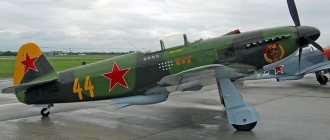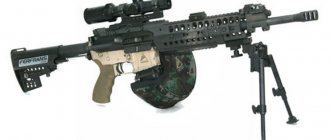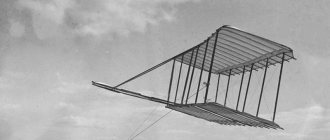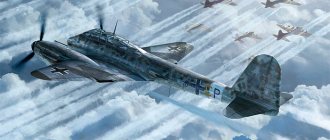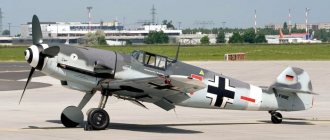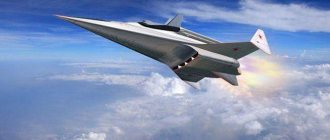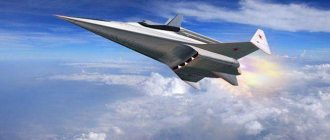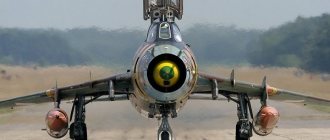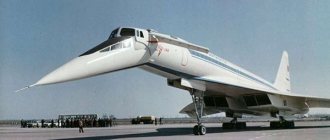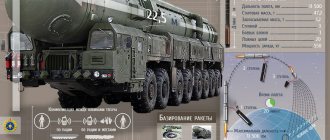War is a terrible word. It brings destruction, casualties, hunger. However, the mobilization at this time of all resources, both physical and mental, can bear fruit that becomes a technological breakthrough, no matter how cynical it may sound. And the Second World War was no exception. It was then that the world's first serial jet combat aircraft was created and its name was Messerschmitt 262 or simply Me-262.
Essentially a revolutionary aircraft, it was never able to help the Luftwaffe regain dominance in the skies. Fortunately, the Germans did not have enough time to finalize it.
History of military aviation from Ilya Muromets to Me-262
If you look at the history of mankind, you can see one interesting trend: people try to use most of all inventions and technological breakthroughs for military purposes, that is, to gain a combat advantage. And aviation was no exception.
Less than 10 years have passed since the emergence of active interest in heavier-than-air aircraft (that is, the birth of aviation as such), and aircraft are already beginning to be used during military operations. The first-born were the French General Picard and the Bulgarian Tsar Ferdinand in 1910 and 1912, respectively.
At that time, the use of aircraft was mainly limited to long-range reconnaissance, but very soon military officials realized the advantages of such equipment and aircraft began to be equipped with various weapons.
World War I
The First World War, which began in 1914, was the first conflict in which aircraft were used as a fighting force. The Russian Empire had the most extensive fleet of aircraft, and its flagship can be considered the large four-engine aircraft Ilya Muromets, which was used as the first bomber.
Germany, whose number of vehicles ranked second, relied on airships at the beginning of the war.
However, Allied aviation was able to prove that the future still belonged to airplanes and the “Teutons” zealously began to create fighters. It was the German engineer Anton Fokker who developed the synchronizer technology, which made it possible to install machine guns on the nose of an aircraft without fear that the bullets would damage the main rotor when firing.
France also distinguished itself in this technology race. Its designers were the first to come up with the idea of installing a machine gun on an airplane. This is how the first fighter appeared. This was the final point in the confrontation between the German airships attacking London and the Allied aircraft.
Another superiority of French design thought lies in the use of missiles, which helped fight the German Fokkers at the end of the first world confrontation. During these years, the first carrier-based aircraft appeared.
Between First and Second
Between the First and Second World Wars, countries began improving existing aeronautics technologies and developing new ones.
Pilots who gained experience during combat operations now acted as testers and participants in air shows, of which many appeared in the 20s.
On them, veterans performed various stunts on airplanes, and races were held. And it was these events that became the impetus for the development of new hulls and power plants.
During times of calm, many records were set, for example: an individual flight across the Atlantic, the first female non-stop flight across the English Channel and the Atlantic Ocean, and so on. It is impossible not to mention the record of compatriot Chkalov - a non-stop flight from Moscow to New York via the North Pole.
A major technological breakthrough was the development of a complex of navigation and flight instruments by the American Jimmy Doolittle. In the early 30s, research and work on the creation of jet engines began, independently in two countries at once - England and Germany.
Aviation developed rapidly and already in the 30s, aluminum replaced wood and fabric from which aircraft bodies were made.
The design of aircraft also changed - biplanes and triplanes faded into the background, making room for monoplanes, whose aerodynamic performance was much higher.
The Second World War
By the beginning of the Second World War, the participating countries approached with different levels of technical equipment. In its early years, Germany, of course, had relative air superiority. The most famous models of that time are considered to be various models of Messerschmitts, including Bf.109, Henkels, for example, He-111, and Junkers, in particular Ju-87.
Jet aircraft developed by the Third Reich, in addition to the Me-262 in question, included the He-162 fighter and the Arado Ar 234 "Blitz" bomber. However, the Germans were unable to maintain this superiority.
The Soviet Union and its allies were able to develop aircraft models that could not only adequately withstand German aircraft, but also surpass them. Among them it is worth mentioning the legendary Soviet La-7 or the English Spitfire.
How the Allies fought ME-262
In direct confrontation with the Messerschmitt 262, any Allied aircraft was doomed to defeat. Losing to him in speed, maneuver and weapon power, one could not even dream of victory. And yet the Achilles heel was found. Not even alone. The fact is that the Messerschmitt-262 jet fighter turned out to be very vulnerable during takeoff and landing. It was decided to rely on these moments in the confrontation with him.
First of all, all forces were thrown into reconnaissance of the airfields where the German “Swallows” were based. After this, their runway was subjected to merciless bombing. It was mixed with soil almost daily. This continued until the Messerschmitt-262, based at the airfield, was transported to another location.
There are also several known facts of the destruction of “Messers” on takeoff. So, on October 7, 1944, Lieutenant Urban Drew, flying through enemy territory, noticed a pair of jet aircraft taking off from the airfield. Using his advantage in altitude and speed, the pilot boldly attacked his opponents and shot down both, preventing them from gaining speed.
Several ME-262s were also destroyed in air battles. Thus, on November 8, 1944, one of the Luftwaffe aces Walter Nowotny, who had previously shot down 258 enemy aircraft, was shot down during an attack by a formation of American bombers by one of the Mustang P-51 fighters covering him.
History of the creation of Me-262
The Me-262 began to be developed in 1938, it was at this time that Willy Messerschmitt's design bureau began work on creating an aircraft with two turbojet engines.
The basis for the development was the technical assignment from the Ministry of Aviation of the Third Reich, on the creation of an experimental model of an aircraft in a turbojet engine of the P3302 type with a thrust of 600 kg.
The engines were developed by BMW, and the first operational samples were planned to be delivered no later than the end of 1939.
Despite the fact that the development specifications were aimed at creating an experimental aircraft, the Messerschmitt Design Bureau initially began developing a platform that could be used as a combat aircraft. The design of the machine was a cantilever all-metal monoplane, the engines were located in engine nacelles located at the bottom of the wing.
The separate placement of the engines was intended to reduce the impact of exhaust gases on the tail. The landing gear had a rather non-standard design at that time with a forward steering wheel; this was done in order to provide better visibility of the aircraft during takeoff and landing.
The wing had the shape of an irregular trapezoid with a slight sweep of the leading edge (18°). The wing mechanization was quite developed and included: automatic slats, slotted flaps, which acted as flaps during landing, and ailerons to control the longitudinal roll of the machine.
The monocoque fuselage had a rather unusual triangular cross-section. It took this appearance due to the large volume of internal fuel tanks and equipment located in the fuselage. The nose compartment of the aircraft housed cannon armament on a retractable carriage.
The pilot's cabin was equipped with pyrotechnic equipment, which made it possible to eject it in an emergency.
This decision was made due to the fact that studies have shown that it is almost impossible to leave the car in the traditional way - by rolling over the side, at a speed of over 600-700 km/h; in addition, there is a real danger of the pilot hitting the tail of the aircraft.
All work directly on the airframe was completed in the spring of 1941, but tests began using the Jumo-210 piston power plant, which was installed in the forward fuselage instead of weapons.
The reason for this was the delay in the delivery of the BMW-003 turbojet engine (working name P 3302), the development of which had not yet been fully completed. The first official flight of the Me-262 took place in 1941 on April 18.
The possibility of installing these turbojet power plants appeared only in November 1941. The first flight as a jet aircraft took place in March of the same year. Moreover, both BMW-003s failed in the air. The prudently left piston engine helped the pilot land the car and avoid a disaster.
Further tests showed not only the low fault tolerance of BMW engines, but also their low power, that is, low traction. Therefore, it was decided to replace them with Jumo-004 turbojet power plants produced by Messerschmitt itself. They were superior to BMW's creation, both in terms of reliability and traction force (up to 1000 kg).
Work to change the engine nacelles for the new Jumo-004 took several months. With new Me-262 engines, it took off on July 18, 1942.
The tests were more than successful. The maximum speed of the aircraft was more than 800 km/h, and its rate of climb was significantly higher than that of any analogue of that time.
The Luftwaffe leadership appreciated the work of the designers, but the green light for its production was not given.
This was due to the production of piston fighters FW-190 and Bf-109, which at that time were quite successfully coping with enemy aircraft in the air.
Repurposing some of the lines for the production of Me-262 would not only take some time, but would also reduce, albeit not by much, the production of these aircraft. But this did not put an end to development. For further testing and training of personnel from Messerschmitt, the Ministry of Aviation ordered 15 aircraft in the summer of 1942 and another 15 in the late autumn of the same year.
Such leisurely work on the jet aircraft continued until November 1943. On the 26th, Hitler was personally present at the next tests and, having seen the machine in action, was inspired by the idea of creating a jet bomber based on it.
Moreover, chief designer Willy Messerschmitt had already included the possibility of such use of the aircraft in the design. Calling this modification the “Blitzbomber,” Hitler orders the start of production of new bombers.
By that time, Germany had completely lost its air superiority and suffered a number of major defeats on both the Eastern Front and the Mediterranean region. Realizing the inevitability of the opening of the Western Front, the Fuhrer looked for opportunities to inflict maximum damage during the landing of troops, that is, at the moment of their greatest vulnerability.
And this weapon was supposed to be a high-speed bomber based on the Me-262, which would be able to break through the ranks of enemy fighters and drop bombs on ground troops.
The High Command of the Reich Air Force ignored these orders and work in this direction never began.
This was due, firstly, to the need to retrain personnel and pilots, and secondly, to the inappropriateness of such use of the aircraft, in particular its low efficiency as a bomber and the possibility of large losses.
As a result, nothing was prepared for the Allied landings in Normandy, which cost Erhard Milch his post as head of the aviation industry. Further work in this direction did not bring results.
At the end of 1944, under the leadership of Hermann Goering, a special fighter unit was created, equipped with Me-262, under the command of the famous German ace Walter Nowotny. However, its late appearance, a number of flaws in the design of the fighter, lack of training of personnel and lack of materials did not give the combat unit the opportunity to prove itself.
Subsequently, the surviving aircraft went to the Allies and the USSR to become part of their own programs for the creation and development of jet aircraft.
German pilots talk about the new generation aircraft
In 1943, the commander of Luftwaffe fighter aircraft, General Adolf Galland, personally came up with the idea to try out a new machine. He expressed his impressions with a short phrase: “This machine flies as if angels were carrying it.” According to another pilot, Jörg Scypionski, the Messerschmitt 262 (photo of which is contained in the article) was not particularly difficult to fly. The main thing is to do everything according to the instructions, then the car will behave quietly and will not become capricious. Due to the unusually high speed, the main thing in battle was to catch the enemy plane in sight. In this case, the pilot became the king of the situation.
The aircraft's armament was so powerful that one salvo was enough to end everything. Nevertheless, even experienced pilots found it not so easy to cope with this obstinate machine. An indispensable retraining was required, which required a lot of time.
Detailed structure of a jet fighter
The aircraft project implied the maximum use of technological techniques existing at that time. That is, it was supposed to be cheap and easy to produce, which was a definite advantage in war conditions. The materials used were common aluminum alloys, ordinary steel, and direct riveting.
Many parts were made by casting or hot stamping.
The possibility of some error in the weight of most parts also made it easier to manufacture.
Fuselage
The Me-262 fuselage was an all-metal structure, designed according to the principle of a reinforced monocoque.
The sheathing was 2mm sheets of aluminum alloy and steel. The aircraft fuselage can be divided into 3 parts:
- Front. This section housed the main weapon with compartments for ammunition, photographic equipment when using the aircraft as a reconnaissance aircraft, containers with compressed air, as well as a niche for the front landing gear and its folding mechanism.
- Average. This part of the fuselage contained the pilot's cabin, the front of which was covered with armored sheets, and the canopy was made of 100mm impact-resistant glass. Fuel tanks, 900 liters each, were installed in front and behind it. In some cases, an additional 600 liter tank could be installed behind the main one. Their special soft shell made it possible to avoid significant fuel losses during a through breakdown. The cockpit canopy was three-sectional with a sliding middle part. The niche under the cabin itself was intended for mounting the center section. The side landing gear in the retracted state was also located there.
- Rear end. In this part of the fuselage there were systems for attaching the tail, both vertical and horizontal, controlling the horizontal stabilizer (unlike most models of those times, it was controlled), an oxygen supply for the corresponding pilot system, and radio equipment. There was also a compass there.
Wing and tail
The wing design was a two-spar system. The materials for its manufacture were steel and duralumin. The mechanical part was represented by the following elements:
- two-section flaps - separated by engine nacelles;
- automatic slats, that is, changing their position depending on the angle of attack and speed of the aircraft, had a three-section design and were located along the entire length of the front part of the wing, excluding the locations of the nacelles;
- The ailerons, like the flaps, had a two-section design.
The turbojet engine nacelles were attached directly to the wing, and they also provided space for folding landing gear. On the left side of the center section, space was provided for the placement of a pitot tube, part of the instrument that measures flight speed and altitude. The wing was attached to the fuselage using bolted and riveted connections.
The tail has a standard design of that time: the position of the horizontal stabilizer was changed using an electric motor. The handlebars are equipped with trimmers and are weight balanced.
Chassis
The landing gear system had three retractable struts, with one of them located in the bow. Each rack had one wheel equipped with a brake. The process of releasing and retracting the landing gear was carried out by a hydraulic drive, but in an emergency it was also possible to use it manually.
Engines
Two Jumo-004 turbojet engines were used as engines, each of which provided a thrust of 910 kgf, while delivering 8700 rpm. Fastening to the wing was carried out in a special three-point gondola. The engines were started using gasoline starters, each of which had its own fuel supply of 17 liters.
Some modifications of the Me-262 were equipped with launch boosters, which made it possible to significantly reduce the take-off mileage.
They were located at the rear of the fuselage, attached directly to the body.
Short biography of “Jagdferband 744 (J744)”
In March 1945, the headquarters of the new formation was located at the Munich-Riem airfield, from where it began intercepting armadas of Allied bombers that were making daylight raids on Germany. In just over a month, this newly-minted elite air unit already had 45 downed allied aircraft. However, this did not last long. On May 3, 1945, it was defeated by the Allies in Salzburg.
Adolf Galland himself also did not refuse the helm of the aircraft. He took part in many operations to intercept Allied bomber raids. On April 25, during one of them, he was shot down by an American cover fighter, the Republic P-47. The pilot was wounded in both knees and was unable to properly land his fighter on the field riddled with craters.
Armament
Most Me-262 aircraft were equipped with 30mm MK-108 aircraft cannons. There could be two or four, depending on the rest of the equipment. In the four-gun version, the guns were placed in pairs, which made it possible to ensure high accuracy and density of fire. The ammunition capacity of the upper and lower pairs differed: in the first case it was 80 shells, in the second - 100.
There was an attempt to install a 50mm VK 5 aircraft cannon, but it did not go beyond the prototype. When using the aircraft against bombers during daylight hours, 24 unguided air-to-air missiles were installed on the wings.
Flight performance
The performance characteristics of Me-262 are presented in the following table:
| Aircraft length | 10.6m |
| Height | 3.8m |
| Wing span and area | 12.5m and 21.8m2 |
| Weight: empty - take-off (with full ammunition and fuel supply) - maximum permissible - | 3800kg 6400kg 7140kg |
| Power point | 2 TRD Jumo-004 |
| Maximum speed | 855km/h |
| Almost ceiling height | 11000m |
| Combat radius | 1040km |
| Number of people in the crew | 1 |
If we compare the Me-262 with the developments of similar allied technology (the Gloucester Meteor for the British and the Bell P-59 Airacomet for the Americans), the German jet won in almost everything except the maximum ceiling, which for the Meteor was 13,400 m.
Modifications
The main, that is, serial, modifications of the Me-262 were:
- A-1a Schwalbe (Swallow) - the first and most common version of the vehicle, equipped with four 30mm aircraft cannons.
- A-1a/U3 is a small series.
- A-1b - interceptor with installed unguided air-to-air missiles.
- A-2a Sturmvogel (Burevestnik) is a fighter-bomber with the ability to carry 2 aerial bombs weighing 500 kg each. To reduce the weight of the aircraft, a pair of 30mm cannons were removed.
- A-5a is a reconnaissance aircraft with photographic equipment installed in the forward fuselage, instead of the lower pair of 30mm MK-108. There is also an observation window mounted in the cabin floor.
- V-1a is a two-seat training modification.
- B-1a/U1 is a two-seat interceptor for operation at night.
- B-2a is a modification of the previous model using new radar equipment, in particular the FuG-218 station.
- S-1a Heimatschutzer (Defender of the Motherland) is a modification of the interceptor using three engines: two Jumo-004 turbojet engines and a liquid-propellant HWK 109-509A, installed in the tail.
- E - this version provided for the installation of a 50mm VK 5 air cannon, instead of four 30mm MK-108.
Combat use
The Me-262 jet, as a fighter or interceptor, can account for 150 units of enemy aircraft.
At the same time, its own losses amounted to 100 vehicles. And such an exchange, which did not inspire optimism, was due to several reasons:
- lack of sufficient qualifications among pilots and maintenance personnel;
- design flaws of the Jumo-004 turbojet engine, in particular its low reliability and survivability in combat conditions;
- lack of fuel and spare parts due to disrupted German communications at the end of the war.
There is no data at all on the performance of the Me-262 as a bomber.
Winners of the Messerschmitt-262 jets: Eastern Front
In addition to the Western European theater of operations, Messerschmitt-262 also appeared on the Eastern Front. True, information about this is quite scanty. Nevertheless, the list of winners of Messerschmitt-262 also includes the names of Soviet aces. Ivan Kozhedub, Lev Sivko, Ivan Kuznetsov, Yakov Okolepov and Alexander Dolgunov have officially registered downed jet Messers. Presumably, two more names should be included in this list: Harry Merkviladze, a pilot of the 152nd Guards Aviation Regiment, and Vladimir Yegorovich from the 402nd Fighter Aviation Regiment.
However, no confirmation of their victories was found in the archives.
A trace in the history of aviation
After the victory over Germany in World War II, technical documentation from the factories and design bureaus of the Third Reich fell into the hands of the Allies and the USSR.
Domestic designers, when studying captured aircraft models and their technical documentation, considered the idea of copying the Me-262 with its subsequent modernization, but this decision was rejected and their own developments received the green light.
However, it is worth saying that some of the successful solutions embodied in the German turbojet fighter were reflected in the design work of Soviet engineers, for example, the RD-10 power plant is a modified version of the Jumo-004B engine.
Until 1951, Czechoslovakia used its own S-92 jet aircraft, which are complete copies of the Me-262, as training aircraft. Their production became possible thanks to the location in this country during the war of a complex of enterprises that produced all the parts for the fighter. Even work was carried out to modify it, but they did not go beyond prototypes.
Victories of German pilots
The first victory behind the wheel of a Messerschmitt 262 jet was won by Adolf Schreiber. This event took place on June 26, 1944. In addition to the above pilots, Messerschmitt-262 helped Franz Schall become famous - he scored 14 victories on the ME-262 (137 in total), Hermann Buchner - 12 (58), Georg Peter Eder - 12 (78), Erich Rudorfer - 12 (222) , Karl Schnorrer – 11 (46), Johannes Steinhoff – 6 (176), Walter Nowotny (total 248 victories), etc.
German pilots considered the Messerschmitt 262 so invulnerable that they boldly entered into battles with an enemy many times superior in numbers. So, on March 19, 1945, 28 German pilots, being at the controls of the Meserschmitt-262, were not afraid to engage in battle with a huge cloud of American aircraft, consisting of 1,300 bombers and 750 cover fighters. Despite their small numbers, they managed to disperse this entire armada, preventing a raid on one of the German targets.
Extant models and use in simulation video games
Today there are several original or restored models of Me-262:
- in the Air Force Museum in Munich - Me-262;
- at the Royal Air Force Museum in Cosford (UK) - Me-262A-2a;
- at the Washington Aerospace Museum - Me-262A-1a;
- from a private collector from Ohio (USA) - Me-262A-1a;
- the US Navy has Me-262В-1azh;
- in Australia (Treloar Centre) - Me-262A-2a;
- in the Prague Aviation Museum - Me-262A-1a and Me-262A-2a;
- in the South African War Museum - Me-262В-1а/U1.
The Me-262 can be found in several flight simulator video games today. Among them is where the fighter is one of the aircraft of the German development branch, usually acting against the Soviet Il-2 Sturmovik.
Of course, the Me-262 turbojet aircraft is a technological breakthrough of its time in aviation.
In all its characteristics, the aircraft not only outperformed models with piston engines, but also left them far behind. However, many problems, including shortcomings, lack of time and resources, prevented the full potential of this fighter from being fully realized.
Add a comment…
“The tactics of using two-seat night jet fighters involved guiding the aircraft to a formation of bombers, after which the crew had to search for individual targets using the on-board radar. The high speed of the Me-262, thanks to which Welter shot down three Mosquito fighters in January 1945, turned out to be unnecessary when attacking four-engine bombers. For a single-seat fighter attacking a target in the beams of searchlights, high speed became more of a disadvantage than an advantage. Even the two-seater Me-262B, on which, due to the Liechtenstein radar antenna installed in the nose, the speed was reduced by almost 60 km/h, overshot a bomber loaded with bombs, so that the pilot did not have time to open aimed fire. However, the Me-262B crews developed their own tactics that suited the characteristics of their fighters: they began the attack from below and extinguished excess speed while climbing in the last seconds before opening fire.”
“Although the Mosquito did not have small arms or cannon weapons, the two-seat Me-262B, piloted by Lieutenant Herbert Altner, was killed during its attack. Altner himself later recalled: “From the ground we were directed to a Mosquito group, after which we established stable contact with one of the high-speed “Englishmen.” I didn't slow down, but the silhouette of the Mossy in the sight's reticle grew much faster than I expected. He abruptly removed engine thrust, unintentionally creating all the conditions for a fire to occur. Both engines stalled, and my partner and I had no choice but a parachute. My radar operator, Sergeant Rengard Lommatz, was unlucky - during the jump he collided with the keel of the Messerschmitt and died on the ground."
.»
A. Shirokorad. "Bomb Europe."

